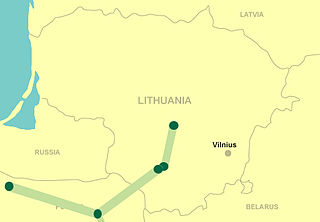
The economy of Afghanistan is listed as the 124th largest in the world in terms of nominal gross domestic product (GDP), and 102nd largest in the world in terms of purchasing power parity (PPP). With a population exceeding 41 million people, Afghanistan's GDP (nominal) stands at $14.58 billion as of 2021, amounting to a GDP per capita of $363.7. As of 2023, annual exports exceed $2 billion, with vegetable products, mineral products, and textiles accounting for 94% of total exports. Total external debt is $1.4 billion as of 2022.

A high-voltage direct current (HVDC) electric power transmission system uses direct current (DC) for electric power transmission, in contrast with the more common alternating current (AC) transmission systems.

The HVDC Cross-Channel is the 73-kilometre-long (45 mi) high-voltage direct current (HVDC) interconnector that has operated since 1986 under the English Channel between the continental European grid at Bonningues-lès-Calais and the British electricity grid at Sellindge. The cable is also known as IFA, and should not be confused with the new IFA-2, another interconnect with France that is three times as long but only half as powerful.
The HVDC Inter-Island link is a 610 km (380 mi) long, 1200 MW high-voltage direct current (HVDC) transmission system connecting the electricity networks of the North Island and South Island of New Zealand together. It is commonly referred to as the Cook Strait cable in the media and in press releases, although the link is much longer than its Cook Strait section. The link is owned and operated by state-owned transmission company Transpower New Zealand.

The Pacific DC Intertie is an electric power transmission line that transmits electricity from the Pacific Northwest to the Los Angeles area using high voltage direct current (HVDC). The line capacity is 3.1 gigawatts, which is enough to serve two to three million Los Angeles households and represents almost half of the Los Angeles Department of Water and Power (LADWP) electrical system's peak capacity.

Path 27, also called the Intermountain or the Southern Transmission System (STS), is a high-voltage direct current (HVDC) electrical transmission line running from the coal-fired Intermountain Power Plant near Delta, Utah, to the Adelanto Converter Station at Adelanto, California, in the Southwestern United States. It was installed by the ABB Group, a company based in Switzerland, and commercialized in July 1986. The system is designed to carry power generated at the power plant in Utah to areas throughout Southern California. It is owned and operated by the Intermountain Power Agency, a cooperative consisting of six Los Angeles-area cities, the largest member being the Los Angeles Department of Water and Power (LADWP), and 29 smaller Utah municipalities.
The East–West Interconnector is a 500 MW high-voltage direct current submarine and subsoil power cable which connects the Irish and British electricity markets. The project was developed by the Irish national grid operator EirGrid.

LitPol Link is an electricity link between Poland and Lithuania which connects the Baltic transmission system to the synchronous grid of Continental Europe. It has a capacity of 500 MW and since 2021 it can operate in a synchronous regime.

Sangtuda 1 Hydroelectric Power Plant is a hydroelectric power plant, located on the Vakhsh River in Tajikistan. Construction commenced during the Soviet period in the 1980s, but halted in the beginning of the 1990s due to lack of financing when the station was about 20% complete. An agreement with Russia allowed to restart the construction, with four units entering service in 2008–2009. The plant was officially commissioned on 31 July 2009. Once working at full capacity, the plant will provide around 12% of Tajikistan's electricity output.

Energy in Afghanistan is provided by hydropower followed by fossil fuel and solar power. Currently, less than 50% of Afghanistan's population has access to electricity. This covers the major cities in the country. Many rural areas do not have access to adequate electricity but this should change after the major CASA-1000 project is completed.

The North Sea Link is a 1,400 MW high-voltage direct current submarine power cable between Norway and the United Kingdom.
The Western HVDC Link is a high-voltage direct current (HVDC) undersea electrical link in the United Kingdom, between Hunterston in Western Scotland and Flintshire Bridge in North Wales, routed to the west of the Isle of Man. It has a transmission capacity of 2,250 MW and became fully operational in 2019.

Renewable energy in Afghanistan includes biomass, geothermal, hydropower, solar, and wind power. Afghanistan is a landlocked country surrounded by five other countries. With a population of less than 35 million people, it is one of the lowest energy consuming countries in relation to a global standing. It holds a spot as one of the countries with a smaller ecological footprint. Hydropower is currently the main source of renewable energy due to Afghanistan's geographical location. Its large mountainous environment facilitates the siting of hydroelectric dams and other facets of hydro energy.

China–Pakistan Economic Corridor (CPEC) is a 3000 km Chinese infrastructure network project undertaken in Pakistan. This sea-and-land based corridor is aimed to secure and reduce the passage for China's energy imports from the Middle East by avoiding existing route from the Straits of Malacca between Malaysia and Indonesia, which in case of a war could be blocked and thus hampering the Chinese energy dependent economic avenues. Developing a deep water port at Gwadar in Arabian Sea and a well built road and rail line from this port to Xinjiang Province in western China would be a shortcut for boosting the trade between Europe and China. In Pakistan, its aim is to overcome an electricity shortfall, infrastructural development and modernize transportation networks. Along with shifting it from an agricultural based economic structure to industrial based.
The Afghanistan–Pakistan Transit Trade Agreement is a bilateral trade agreement signed in 2010 by Pakistan and Afghanistan that calls for greater facilitation in the movement of goods amongst the two countries.
FAB Link is a proposed HVDC Interconnector, spanning the 220 kilometres (140 mi) between France and Great Britain, running close to the island of Alderney.

The Islamic Republic of Afghanistan was a presidential republic that ruled Afghanistan from 2004 to 2021. The state was established to replace the Afghan interim (2001–2002) and transitional (2002–2004) administrations, which were formed after the 2001 United States invasion of Afghanistan that had toppled the partially recognized Taliban-ruled Islamic Emirate of Afghanistan. However, on 15 August 2021, the country was recaptured by the Taliban, which marked the end of the 2001–2021 war, the longest war in US history. This led to the overthrow of the Islamic Republic, led by President Ashraf Ghani, and the reinstatement of the Islamic Emirate under the control of the Taliban. The United Nations still recognizes the Islamic Republic as the legitimate government of Afghanistan instead of the Islamic Emirate, the de facto ruling government. The US–Taliban deal, signed on 29 February 2020 in Qatar, was one of the critical events that caused the collapse of the Afghan National Security Forces (ANSF). Following the deal, the US dramatically reduced the number of air attacks and deprived the ANSF of a critical edge in fighting the Taliban insurgency, leading to the Taliban takeover of Kabul.
The Five Nations Railway Corridor or Five States Railway Corridor is a proposed rail link in Central Asia between Iran in the west, through Afghanistan, Tajikistan, Kyrgyzstan, and reaching China in the east. Around half of the length of the railway would pass through northern Afghanistan. A preliminary agreement for the railway link was first signed in 2014, with costs estimated at US$2 billion, however construction of the main section through Afghanistan is uncertain due to the ongoing conflict in Afghanistan.
Kamaluddin Nezami is an Afghan politician who was appointed governor of Panjshir Province in 2016. As of 6 September 2021, his status as governor is unclear.










